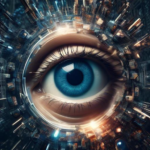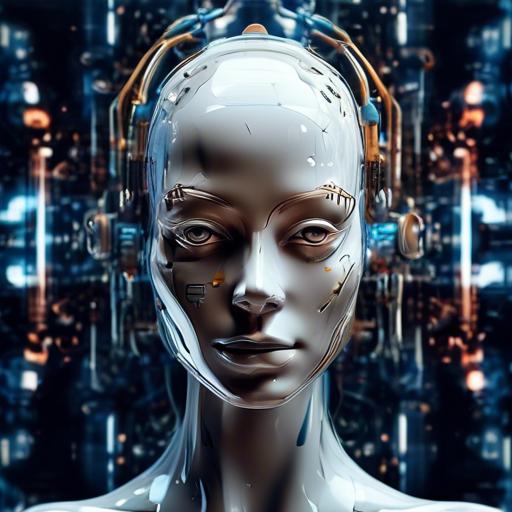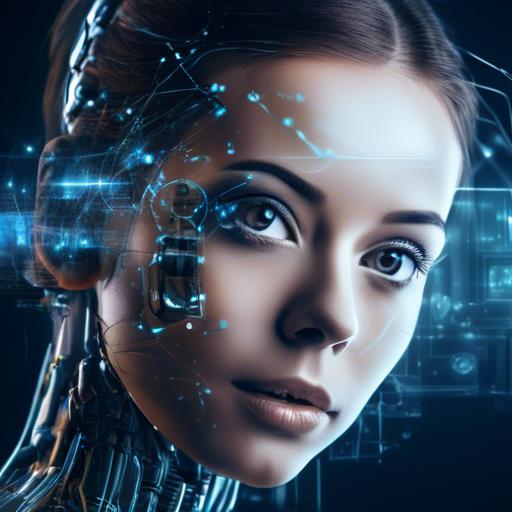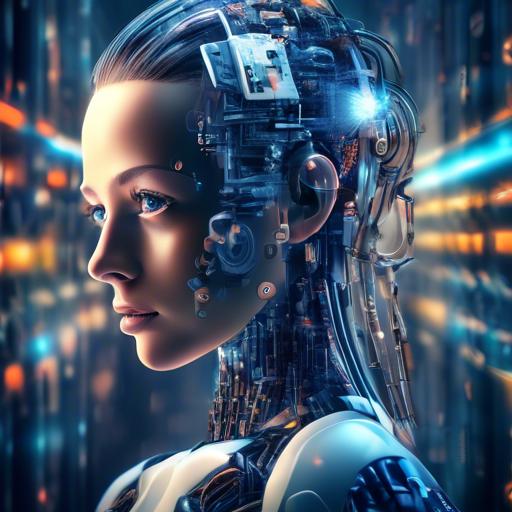In an era where pixels and palettes converge, a silent revolution is painting a new chapter in the canvas of creativity. Imagine a world where artistic visions leap effortlessly from imagination to reality, where designers and dreamers collaborate with intuitive, ever-evolving digital companions. This is not the realm of science fiction, but the vibrant present of artificial intelligence in art and design.
Welcome to the fusion of technology and creativity, where AI serves as both muse and mentor, transforming the landscape of digital art. It’s a space where innovation is boundless, and the impossible becomes merely a starting point. Whether you’re an artist seeking a fresh perspective or a designer navigating the complexities of modern aesthetics, the partnership with AI unlocks doors to unprecedented realms of expression and efficiency. This article embarks on a journey through the kaleidoscopic interplay of AI and digital artistry, unveiling how machine intelligence is reshaping the brushstrokes of the future with support, ingenuity, and a touch of magic.
Table of Contents
- The Evolution of Creativity: AI’s Revolutionary Impact on Digital Art
- From Concept to Creation: AI Tools Enhancing Artistic Expression
- The Fusion of Man and Machine: Collaborative Design in the Age of AI
- Mastering the Palette: How AI Algorithms Perfect Color Choices
- Streamlining Workflow: AI in Design Efficiency and Productivity
- Personalization at its Peak: Customizing Art with AI
- Breaking Boundaries: AI Empowering Non-traditional Artists
- Embracing Innovation: AI’s Role in Shaping Future Design Trends
- Insights and Conclusions
The Evolution of Creativity: AI’s Revolutionary Impact on Digital Art
One of the most fascinating transformations brought by AI in the realm of digital art is its ability to render and generate artwork that rivals human creativity. With the inception of tools like DALL-E, DeepDream, and MidJourney, artists can now explore realms of artistry previously believed to be beyond the human imagination. **AI algorithms** can analyze vast amounts of data to create unique patterns, color schemes, and even entire compositions, allowing artists to push the boundaries of their creativity.
AI has democratized art, making it accessible to individuals who might not have had formal training. Beginners can use AI-powered tools to create stunning pieces. This accessibility is transforming not only how art is made but also who gets to be an artist. The implications are profound; **more voices are being added to the artistic conversation** than ever before.
Examples of how AI is impacting digital art:
- Automated Image Creation: Tools like MidJourney can generate images based on textual descriptions, making it easier for artists to visualize their ideas.
- Style Transfer: AI can blend different artistic styles, enabling artists to discover and create hybrid styles that are both unique and captivating.
- Enhanced Editing Tools: AI in software like Adobe Photoshop offers powerful features that automate complex editing tasks, speeding up the creative process.
| AI Tool | Primary Function | Artist Benefit |
|---|---|---|
| DALL-E | Text-to-Image Creation | Visualize Descriptive Ideas |
| DeepDream | Pattern Creation | Generate Surreal Art |
| MidJourney | Art Style Experimentation | Discover Unique Styles |
While there are concerns about the originality and authenticity of AI-generated art, it is essential to see AI not as a competitor but as a collaborator. The **collaborative possibilities** are endless, providing artists with new tools to experiment and innovate. The key lies in how we, as humans, incorporate these tools into our creative processes, ensuring that **AI complements rather than replaces** the human touch.
From Concept to Creation: AI Tools Enhancing Artistic Expression
The world of digital art and design is experiencing a revolution, thanks to the integration of advanced AI tools. These tools are reshaping the boundaries of artistic expression, enabling creators to unlock new levels of creativity and efficiency.
AI-Driven Inspiration: One of the most remarkable aspects of AI in the artistic realm is its ability to provide inspiration. AI algorithms analyze vast amounts of data to generate unique patterns, compositions, and color palettes that artists can use as a foundation for their work. By leveraging AI, artists can access an endless stream of ideas which can dramatically enhance the creative process.
- Generative Adversarial Networks (GANs): These models can create highly realistic images from scratch, pushing the envelope of what’s possible.
- Style Transfer: Artists can effortlessly apply the style of one image to another, merging different artistic elements in novel ways.
- AI Brush Tools: Intelligent brushes adjusted automatically based on the desired effect, allowing for more precise and expressive strokes.
Efficiency and Collaboration: Beyond inspiration, AI tools streamline various aspects of the design process. From automating repetitive tasks like background removal to suggesting optimal design layouts, AI reduces the workload on artists, enabling them to focus more on the essence of their work. Additionally, AI fosters collaboration, with platforms allowing multiple creators to co-design in real-time, seamlessly blending human creativity with artificial intelligence.
| AI Tool | Function |
|---|---|
| DeepArt | Applies artistic styles to photos |
| Runway ML | Real-time collaboration and video editing |
| Adobe Sensei | Automated design and layout suggestions |
Pushing the Boundaries of Imagination: The true magic of AI in digital art lies in its ability to push the boundaries of what we previously thought possible. Artists are no longer confined by technical limitations or traditional methods. They can experiment with new mediums, such as virtual reality or interactive installations, knowing that AI will support and enhance their vision. This symbiotic relationship between human creativity and artificial intelligence is opening doors to uncharted artistic territories, allowing for more dynamic and immersive experiences.
The Fusion of Man and Machine: Collaborative Design in the Age of AI
In the realm of digital art and design, **artificial intelligence** is revolutionizing the landscape, facilitating a symbiotic relationship between human creativity and machine precision. Artists and designers are now collaborating with AI to produce work that pushes the boundaries of imagination.
The **tools** at an artist’s disposal have expanded dramatically, incorporating algorithms that can:
- Generate unique patterns and textures
- Enhance color palettes
- Suggest design elements based on minimal input
These capabilities allow for faster iterations and more diverse creative outputs.
Innovative AI platforms are becoming co-creators rather than mere tools. Programs like Adobe Sensei and DeepArt are pioneering this movement, enabling **seamless integration** of AI into the creative process. Through machine learning, these platforms analyze vast amounts of data to predict and propose designs that match an artist’s style and vision.
| AI Tool | Functionality |
|---|---|
| Adobe Sensei | Personalized design recommendations |
| DeepArt | Style transfer and pattern generation |
| RunwayML | Real-time video editing |
This collaborative design approach notably impacts **workflow efficiency** and **innovation potential**. By offloading repetitive tasks to AI, creators can focus on high-level conceptual development. Moreover, AI’s ability to process and utilize large datasets enables designers to draw inspiration from sources and styles they might not have considered, fostering a rich tapestry of creative possibilities.
Mastering the Palette: How AI Algorithms Perfect Color Choices
The unique ways artificial intelligence assists artists and designers in choosing colors is nothing short of revolutionary. **AI algorithms** analyze vast amounts of data and learn from color theories, user preferences, and even psychological impacts of different hues. By understanding the interplay of color, AI can recommend palettes that evoke specific emotions or draw attention to certain elements in a design.
- **Context-Aware Suggestions:** Imagine an AI that perceives the content of your artwork and dynamically adjusts the color palette to highlight key elements. Whether you’re working on a serene landscape or a bustling urban scene, the AI ensures every hue complements your artistic vision.
- **Color Harmony:** Leveraging principles like the *Golden Ratio* and *Color Wheel Theory*, AI ensures that the chosen colors are harmonious. It balances warm and cool tones, maintains contrast, and avoids jarring combinations that might detract from the overall aesthetic.
- **Cultural Sensitivity:** Colors hold different meanings across cultures. An AI trained on regional data can suggest palettes that resonate with specific audiences, ensuring your design is both beautiful and culturally appropriate.
Another incredible feature is the ability to **generate custom palettes** based on input images or themes. Upload a photo of a sunset, and the AI will extract the rich oranges, purples, and blues, offering you a ready-made palette that can be used across various elements of your design project. This not only saves time but also provides a cohesive and immersive visual experience.
Here’s a quick comparison of how AI enhances the color selection process:
| Traditional Method | AI-Assisted Method |
|---|---|
| Manual with human intuition | Automated suggestions based on data analysis |
| Time-consuming color matching | Instantaneous harmony checks |
| Prone to subjective bias | Objective and culturally aware choices |
By using AI-powered tools, designers and artists can focus more on the creative aspects of their work, leaving the technicalities of color choice to their intelligent assistants. This symbiotic relationship enhances productivity and ultimately leads to more stunning and impactful visual creations.
Streamlining Workflow: AI in Design Efficiency and Productivity
In the bustling world of digital art and design, AI is revolutionizing the way creative professionals approach their workflow. From idea conception to final execution, the integration of AI tools into the design process not only enhances **efficiency** but also fosters remarkable **productivity**.
Imagine the liberation of your creative energy when mundane, repetitive tasks are handled autonomously by AI. Tasks such as color palette suggestions, background adjustments, and even aesthetic balance assessments are instantly streamlined with the use of intelligent design assistants. This allows designers more breathing room to focus on what they do best – creating astounding visuals and innovative concepts.
- Automated Pattern Recognition: Recognizing and generating patterns to fit brand guidelines effortlessly.
- Enhanced Collaboration: Real-time feedback and suggestions through AI-powered collaborative platforms.
- Dynamic Prototyping: Instant adjustments and iterations, speeding up the review and approval process.
The integration of AI also transcends into advanced tools like machine learning algorithms that can predict design trends and give insights ahead of the curve. By analyzing enormous datasets, these algorithms can forecast what styles, colors, and elements resonate most with target audiences, ultimately giving designers a competitive edge.
Additionally, AI’s impact on productivity can be quantitatively measured. The table below provides a brief comparison of traditional versus AI-enhanced workflows in a typical design project.
| Workflow Stage | Traditional Time (hrs) | AI-Enhanced Time (hrs) |
|---|---|---|
| Sketching & Ideation | 10 | 6 |
| Prototype Development | 8 | 4 |
| Feedback & Revisions | 5 | 2 |
As the table clearly illustrates, leveraging AI can significantly cut down on the hours spent at each stage of the workflow. This efficiency gain not only translates to higher output but also to improved mental well-being for designers, as they can reduce the strain of tight deadlines and creative blocks.
With these powerful tools at their disposal, designers are empowered to push the boundaries of their creativity while maintaining a harmonious balance between imaginative freedom and practical efficiency. The future of digital art and design is indeed bright, with AI lighting the path to unparalleled innovation.
Personalization at its Peak: Customizing Art with AI
The convergence of artificial intelligence and digital artistry has opened up a panorama of customization possibilities that were once the province of human artisans. Imagine if every brushstroke on a canvas, every pixel in a digital illustration, could be tailored to meet your specific desires and aesthetic preferences. **AI-driven tools** are making this dream a reality, offering artists and designers unparalleled capabilities to infuse their personal touch into their creations.
- **AI Algorithms**: Customized palettes and styles based on user inputs.
- **Pattern Recognition**: Tailoring designs to match favored themes.
- **Interactive Feedback**: Real-time adjustments to meet evolving tastes.
This tailoring process transcends merely selecting a predetermined filter or template. Instead, AI algorithms analyze user interactions and preferences to suggest adjustments that harmonize with individual tastes. Artists can now take advantage of **pattern recognition technologies** to craft unique designs that resonate more deeply with their audience.
| Feature | Benefit |
| Style Synthesis | Combine multiple artistic styles seamlessly |
| Predictive Texturing | Generate realistic textures based on user input |
| Color Theory Integration | Auto-adjust colors to maintain visual harmony |
The transformative potential of AI’s customization extends to both novice artists and seasoned professionals. With advanced tools, artwork can be fine-tuned in ways that previously required years of expertise. Novices can leap into the creative process with less hesitation, while professionals can enhance their workflows and explore inventive avenues.
The journey to greater personalization doesn’t stop at visual aesthetics. AI’s adaptability allows artists to integrate elements like **soundscapes** and **interactive features** into their digital art, creating immersive experiences that are as dynamic as they are personalized. Advanced neural networks enhance these features by learning from user interactions, ensuring that each piece evolves according to its envisaged artistic intention.
Breaking Boundaries: AI Empowering Non-traditional Artists
The dynamic evolution of AI is catalyzing a radical transformation in the world of digital art and design, breaking down barriers and democratizing the creative process. These technological advancements are **enabling non-traditional artists** to express their creativity in unprecedented ways. For the hobbyist or emerging artist, AI-powered tools offer a gateway to professional-level artistry without the need for formal training.
Consider the rise of AI-generated art that can **mimic intricate design patterns**, enhance color palettes, or even predict the next brushstroke. This allows artists to experiment and innovate, expanding their creative horizons. Platforms such as **DeepArt** and **RunwayML** provide accessible resources to generate stunning visual art through algorithms, making high-quality digital art more attainable than ever.
Additionally, AI’s impact stretches beyond just visual aesthetics—it significantly contributes to designing user-friendly interfaces and crafting intricate 3D models. These tools offer features like automatic design correction and style recommendations, giving both novice and seasoned designers a fresh perspective. Imagine creating a complex character model or an interactive web design with the assistance of algorithms that **instantly detect flaws** and suggest improvements.
| AI Tool | Primary Use | Key Features |
|---|---|---|
| DeepArt | Visual Art Generation | Style Transfer, Color Enhancement |
| RunwayML | Creative Algorithms | Real-time Processing, Collaborative Workflows |
| Autodesk Maya | 3D Modeling | AI-Enhanced Sculpting, Automated Rigging |
| Canva | Graphic Design | Design Templates, AI Suggestion Tools |
Innovators are leveraging AI for creating hyper-personalized artwork, translating their unique visions into digital masterpieces. This personalized touch not only enhances user engagement but also celebrates diverse perspectives and styles. The infusion of AI in design processes is **transforming collaboration**, allowing multiple creatives to work on a single project simultaneously, no matter where they are located.
With AI technologies increasingly bridging the gap between imagination and execution, the future of digital art and design looks more inclusive and vibrant. Even those who once felt limited by a lack of technical skill can now see their wildest creative dreams realized. AI empowers them to break boundaries, harnessing the full potential of their creativity.
Embracing Innovation: AI’s Role in Shaping Future Design Trends
Stepping into the digital age, **AI-driven innovations** are orchestrating a symphony of unprecedented creativity. As automation and machine learning algorithms take center stage, the landscape of digital art and design is witnessing a miraculous transformation.
- AI-Powered Creativity: AI tools are no longer just assistants; they have become co-creators. Artists can now collaborate with AI to envision and materialize designs that were once thought impossible, from surrealist landscapes to dynamic generative art.
- Effortless Prototyping: Gone are the days of endless iterations. AI accelerates the prototyping process, converting rough sketches into polished designs swiftly. This allows designers to spend more time on refining their visions.
- Smart Design Modifications: With AI, making adjustments has become intuitive. Designers can generate multiple variations of a design instantly, catering to different aesthetic preferences and functional requirements.
Incorporating AI into design workflows also introduces the possibility of hyper-personalization. Algorithms can study user behavior and preferences, delivering designs that are incredibly tailored to individual tastes. Whether it’s a website layout, app interface, or marketing graphic, each element can be customized to engage specific audiences effectively.
| Aspect | Traditional Design | AI-Enhanced Design |
|---|---|---|
| Turnaround Time | Weeks to Months | Days to Weeks |
| Customization Level | Limited | Extensive |
| Resource Needs | High | Moderate |
**AI in design** also democratizes creativity. Advanced tools are more accessible than ever, allowing even novice designers to craft visually stunning work. This not only encourages diverse design perspectives but also propels a community-driven innovation cycle.
Ultimately, the fusion of artificial intelligence and design is an exhilarating journey. As AI continues to inspire, iterate, and perfect, the future of digital art and design beckons with endless possibilities. Embrace the change, and let your creativity soar to uncharted territories.
Insights and Conclusions
The marriage of artificial intelligence and digital art is a match made in creative heaven. As we continue to witness the transformative power of AI in shaping the future of design, the possibilities are truly endless. Whether it’s revolutionizing the way we create, enhancing our artistic capabilities, or pushing the boundaries of imagination, the synergy between AI and digital art is paving the way for a new era of innovation. So embrace the potential, unlock your creativity, and let AI inspire you to create art that knows no bounds. The future is bright, and the canvas of possibilities is infinite – so paint boldly, dream big, and let your imagination soar with the power of AI.
































